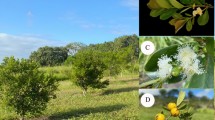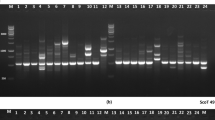Abstract
As an oilseed crop, the cultivation of Ethiopian mustard (Brassica carinata) is restricted only to Ethiopia. Even though geographic diversity is a potent source of allelic diversity, the extent of genetic diversity among germplasm material of Ethiopian mustard from different countries has not been assessed. Forty-three accessions, comprising 29 accessions from eight different geographic regions of Ethiopia and 14 exotic accessions from Australia, Pakistan, Spain, and Zambia were analysed for their genetic diversity using random amplified polymorphic DNA (RAPD) technique. A set of 50 primers yielded a total of 275 polymorphic bands allowing an unequivocal separation of every Ethiopian mustard accession. The usefulness of the 50 RAPD primers in measuring heterozygousity and distinguishing accessions was variable such that polymorphic information content (PIC) varied from 0.05 to 0.40, band informativeness (BI) from 0.05 to 0.65 and primer resolving power (RP) from 0.15 to 6.83. Jaccard's similarity coefficients ranged from 0.44 to 0.87 indicating the presence of a high level of genetic diversity. On the average, Australian and Ethiopian accessions were the most similar while, Spanish and Zambian accessions were the most distant ones. Cluster analysis grouped the 43 accessions into four groups, which has quite a high fit (r = 0.80) to the original similarity matrix. With no prior molecular information, the RAPD technique detected large genetic diversity among the 43 accessions from five different countries and their grouping by dendrogram and principal coordinate analysis (PCoA) was inclined towards geographic differentiation of RAPD markers. Conversely, RAPD differentiation along geographic origin was not apparent within the Ethiopian accessions.
Similar content being viewed by others
References
Abebe D., Dawit T., Getahun M. and Debritu B. 1992. Ethiopia's genetic resources of oilseeds. In: Proc. 1st Nat. Oilseeds Workshop. Institute of Agricultural Research. Addis AbabaEthiopia. pp. 12–17, 3–5 Dec. 1991.
N. Alemayehu and H.C. Becker, Genotypic diversity and pattern of variation in a germplasm material of Ethiopian Mustard (Brassica carinata A. Braun). Genet. Resour. Crop Evol 49 (2002) 573-582
Amersham International PLC. 1997. Nucleon Extraction and Purification Protocols.
J.A. Anderson, G.A. Churchill, S.D. Antrique, S.D. Tanksley and M.E. Sorelles, Optimising parental selection for genetic linkage maps. Genome 36 (1993) 182-186
A. Ayana, T. Bryngelsson and E. Bekele, Genetic variation of Ethiopian and Eritrean sorghum (Sorghum bicolor (L.). Moench) germplasm assessed by random amplified polymorphic DNA. Genet. Resour. Crop Evol 47 (2000) 471-482
K.V. Bhat, P.B. Prashant and L. Suman, Study of genetic diversity in Indian and exotic sesame (Sesamum indicum L.) germplasm using random amplified polymorphic DNA (RAPD) markers. Euphytica 110 (1999) 21-33
G. Birmeta, H. Nybom and E. Bekele, RAPD analysis of genetic diversity among clones of the Ethiopian crop plant Ensete ventricosum. Euphytica 124 (2002) 315-325
R.L. Cansian and S. Echeverrigarary, Discrimination among cultivars of cabbage using random amplified polymorphic DNA markers. Hortiscience 35 (2000) 1155-1158
K.P.S. Chandel and B.S. Joshi, Multivariate analysis in green-seeded pea. Indian. J. Agric. Sci 53 (1983) 198-200
W.Y. Cheung, G. Champagne, N. Hubert and B.S. Landry, Comparison of the genetic maps of Brassica napus Brassica oleracea. Theor. Appl. Genet 94 (1997) 569-582
S. Das, J. Rajagopal, S. Bhatia and P.S. Srivastava, Assessment of genetic variation within Brassica campestris cultivar using amplified length polymorphism and random amplified polymorphic DNA markers. J. Biosci. Bangalore 24 (1999) 433-440
T. Demeke, R.P. Adams and R. Chibbar, Potential taxonomic use of random amplified polymorphic DNA (RAPD): a case study in Brassica. Theor. Appl. Genet 84 (1992) 990-994
I. Divaret, E. Margale and G. Thomas, RAPD markers on seed efficiently asses the genetic diversity of Brassica oleracea L. collection. Theor. Appl. Genet 98 (1999) 1029-1035
J. Felsenstein, PHYLIP-Phylogenetic inference package (Ver. 3.2). Cladistics 5 (1989) 164-166
M.E. Fernandez, A.M. Figureueiras and C. Benito, The use of ISSR and RAPD markers for detecting DNA polymorphismgenotype identification and genetic diversity among barley cultivars with known origin. Theor. Appl. Genet 104 (2002) 845-851
O.H. Frankel, A.H.D. Brown and J.J. Burdon, The Conservation of Plant Biodiversity. Cambridge: Cambridge University Press (1995).
G. Hawtin, M. Iwanaga and T. Hodgkin, Genetic resources in breeding for adaptation. In: P.M.A. Tigerstedt (ed.) Adaptation in Plant Breeding. The Netherlands: Kluwer Academic Publisher (1997) pp. 277-288
J.S. Hemingway, Mustards: Brassica spp. and Sinapis alba (Cruciferae). In: J. Smartt and N.W. Simmonds (eds.) Evolution of Crop Plants. Singapore: Longman Scientific and Technical (1995) pp. 82-88
B. Hiruy, K.W. Riley, T. Nigatu and A. Getinet, The responses of three oilseeds Brassica species to different planting date and rate in highlands of Ethiopia. Ethiopian J. Agric. Sci 5 (1983) 22-33
A. Jain, S. Bhatia, S.S. Banga, S. Prakash and M. Lakshmikumaran, Potential use of random amplified polymorphic DNA (RAPD) technique to study the genetic diversity in Indian mustard (Brassica juncea) and its relationship to heterosis. Theor. Appl. Genet 88 (1994) 116-122
R.J. Mailer, R. Scarth and B. Fristensky, Discrimination among cultivars of rapeseed (Brassica napus L.) using DNA polymorphism amplified from arbitrary primers. Theor. Appl. Genet 87 (1994) 697-704
B.F.J. Manly, Multivariate Statistical Methods: A Primer. New York: Chapman and Hall (1986).
A.E. Melchinger, A. Graner, M. Singh and M.M. Messmer, Relationships among European barley germplasm: I. Genetic diversity among winter and spring cultivars revealed by RFLPs. Crop Sci 34 (1994) 1191-1198
J.V. Monte, C.L. McIntyre and J.P. Gustafson, Analysis of phylogenetic relationships in the Triticeae tribe using RFLPs. Theor. Appl. Genet 86 (1993) 649-655
A. Prevost and M.J. Wilkinson, A new system of comparing PCR primers applied to ISSR fingerprinting of potato cultivars. Theor. Appl. Genet 98 (1999) 107-112
D.I. Puecher, C.G. Robredo, R.D. Rios and P. Rimieri, Genetic variability measures among Bromus catharticus Vahl. populations and cultivars with RAPD and AFLP markers. Euphytica 121 (2001) 229-236
M.A. Rabbani, I. Aki, M. Yoshie, S. Tohru and T. Kenji, Genetic diversity in mustard (Brassica juncea L.) germplasm from Pakistan as determined by RAPDs. Euphytica 103 (1998) 235-242
J.A. Rafalski and S.V. Tingey, Genetic diagnostics in plant breeding: RAPDs, microsatellites and machines. Trends Genet 9 (1993) 275-280
Rakow G. 1995. Developments in the breeding of edible oil in other Brassica species. In: Proceedings of the 9th International Rapeseed Conference. 4–7 July, 1995. CambridgeU.K., pp. 401–406.
J. Ren, J.R. McFerson, R. Li, S. Kresovich and W.F. Lamboy, Identities and relationships among Chinese vegetable Brassicas as determined by random amplified polymorphic DNA markers. J. Amer. Soc. Hort. Sci 120 (1995) 548-555
F.J. Rohlf, NTSYS-pc Numerical Taxonomy and Multivariate Analysis System. New York, USA: Exeter Software (2001).
N.W. Simmonds, Principles of Crop Improvement. New York: Longman Group (1979).
B.D. Singh, Plant Breeding Principles and Methods. New Delhi: Kalyana Publishers (1996).
Thormann C.E. and Osborn T.C. 1992. Application of RAPD technology to plant breeding: joint plant breeding symposia. 1 November 1992, Minneapolis, Minnesota. Crop Sci. Soc. Amer., Amer. Soc. Hort. Sci., Amer. Genet. Assoc pp. 9–11.
U N. 1935. Genome analysis in Brassica. Jap. J. Bot. 7: 389–452.
P.S. Virk, B.V. Ford-Llyod, M.T. Jackson and H.J. Newbury, Use of RAPD for the study of diversity within plant germplasm collections. Heredity 74 (1995) 170-179
J.G.K. Williams, M.K. Hanafey, J.A. Rafalski and S.V. Tingey, Genetic analysis using RAPD markers. Method. Enzymol 218 (1993) 704-740
J.G.K. Williams, A.R. Kubelik, K.J. Livak, J.A. Rafalski and S.V. Tingey, DNA polymorphisms amplified by arbitrary primers are useful as genetic markers. Nucleic Acids Res 18 (1990) 6531-6535
Author information
Authors and Affiliations
Corresponding author
Rights and permissions
About this article
Cite this article
Teklewold, A., Becker, H. Geographic Pattern of Genetic Diversity Among 43 Ethiopian Mustard(Brassica carinata A. Braun) Accessions as Revealed by RAPD Analysis. Genet Resour Crop Evol 53, 1173–1185 (2006). https://doi.org/10.1007/s10722-005-2011-4
Received:
Accepted:
Published:
Issue Date:
DOI: https://doi.org/10.1007/s10722-005-2011-4




